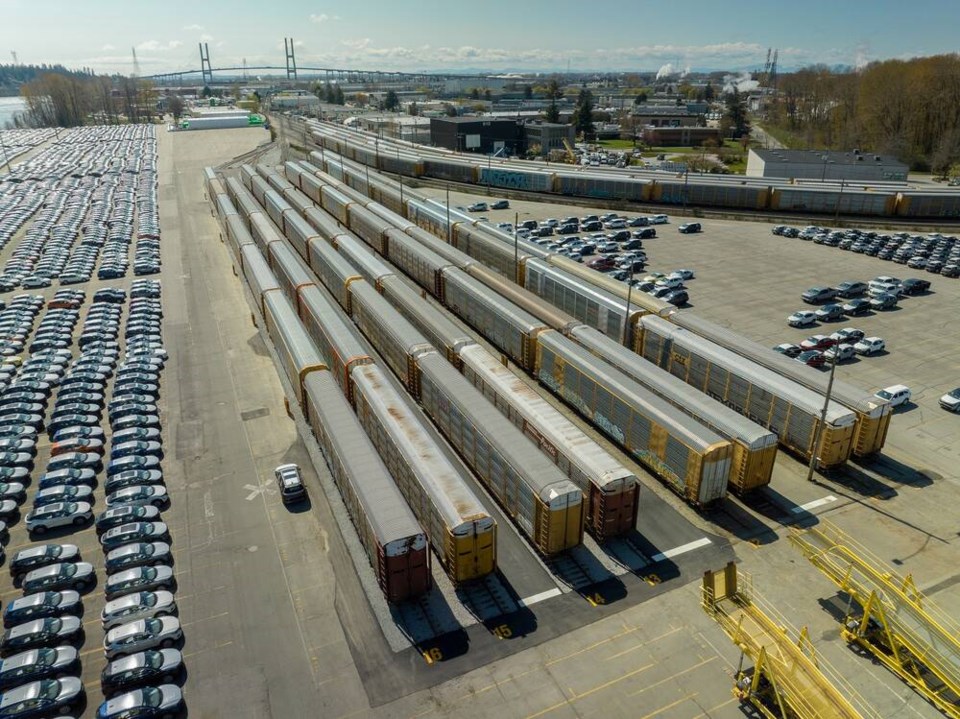It’s a major upgrade in Delta for the Vancouver Fraser Port Authority that will now open the door for an entirely big new project across the river in Richmond.
The port and Wallenius Wilhelmsen announced the completion of the Annacis Auto Terminal Optimization Project.
Construction, which began in 2022, involved consolidating the Annacis Auto Terminal and Richmond Auto Terminal into a single facility at Annacis.
The improvements will allow the single terminal, operated by Wallenius Wilhelmsen, to handle up to 480,000 vehicles annually, a 36 per cent increase in capacity.
The project included the creation of 60 rail car spots through the expansion of two existing terminal rail yards, a new vehicle processing building, along with the installation of eight electric vehicle charging stations, the port authority explained.
From initial planning to completion, the project was undertaken in a timely manner because the permitting and consultation process was undertaken by the port authority. That was unlike the Terminal 2 container terminal project at Roberts Bank, which took well over a decade, due to that project going through a different because it was designated under the Impact Assessment Act.
While the auto terminal project will improve efficiency of the existing operations and increase capacity to handle a greater volume of automobile imports, it also gives the port the rare ability to have new separate project built at the 40-acre Richmond site, located off Steveston Highway at the southside of No. 6 Road.
“This project really had a couple of really strong benefits from a port authority perspective. It does really allow the most efficient of our limited footprint. It allows more product to move through the existing site, consolidating two auto terminals into one. We have also freed up a 40-acre site in Richmond that can now be used for a new import marine terminal. By consolidating all the volume on the one site at Annacis Island by making improvements to use that footprint more efficiently, it’s really about doing more with our existing asset,” the port’s Jennifer Natland, Vice-President of Properties and Environment, told the Optimist.
Natland noted that they anticipate going to market in about a year to gauge interest in the development of a new marine terminal in Richmond, and they have already heard interest, but they may also in the interim have short-term users for the site while it’s being prepared for the longer term.
As far as the challenge of having enough land, Natland acknowledged the port is “very land constrained” and it’s one of the key challenges in accommodating Canada’s growing trade demand.
“We look at land for the port in two different ways. There’s the waterfront land to support marine terminals and then there’s inland industrial land needed for the supply chain and the logistics that support those marine terminals. Both types of land, from a port perspective, are very constrained, and the Annacis Auto consolidation project has freed up a very rare waterfront site for the new marine terminal. I can count on one hand how many opportunities there are in the Port of Vancouver to build a new marine terminal, and this is really a premier opportunity,” she added.
Tim McGee, Vice-Present of Canada Operations for Wallenius Wilhelmsen, said they currently process about 28 per cent of all new vehicles sold in Canada through the facility.
He said the faster processing times will mean reducing bottlenecks and reducing vessels delays, while cars that have been sitting at the terminal from 12-to-14 days while being processed will now going through in four-to-six-days.
In a news release, Chrystia Freeland, Canada’s Minster of Transport and Internal Trade, noted that by improving the efficiency of cargo movement at the Annacis Auto Terminal, they are supporting the growth of the economy and ensuring that Canadian businesses are competitive on the national and global stage.
The project was funded by the Government of Canada through the National Trade Corridors Fund, the port authority and Wallenius Wilhelmsen. It is one of the nearly 40 infrastructure projects proposed as part of the Greater Vancouver Gateway 2030 strategy, the port notes.



